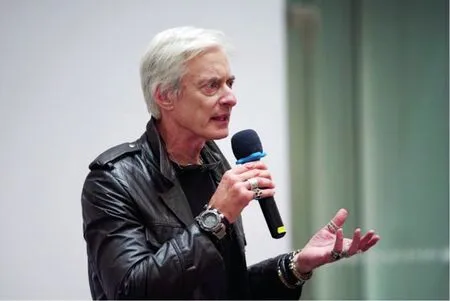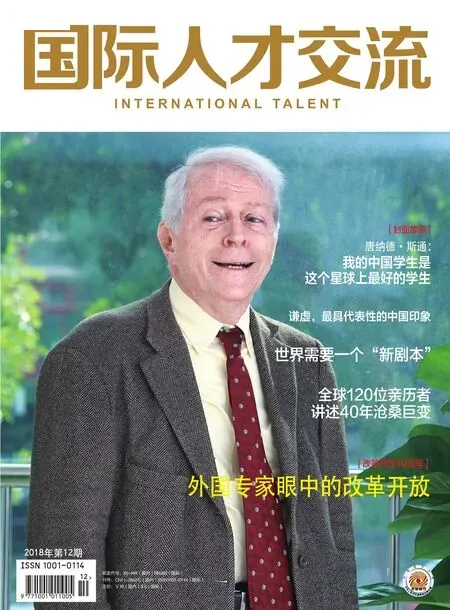Re-engineering the enterprises
2018-12-18ByLaurenceBrahm
By Laurence Brahm
1994: As a young lawyer travelling across China negotiating joint ventures, each day I was living on the inside of a massive experiment to re-engineer China’s State-owned enterprises. Every time a foreign company joint ventured with a Chinese Stateowned enterprise, it meant restructuring the local partner. I spent years in factories, re-organizing enterprise management,assets, and finding creative ways to convert debt to equity.
Power 28 experiment
My pet project was Power 28, a national detergent brand factory located in the center of Hubei province-smack in the center of China. It was the archetypical State-owned enterprise. Run by a creative cadre-cum-local leader named Teng Jixin. Aside from making soap and detergent Teng launched a spectrum of side ventures from sanitary napkins, bottled water, to karaoke dance clubs and restaurants. The enterprise was burdened with uncollectable receivables and awash in debt. But like most State-owned enterprises the management was not incentivized to seek profit. Life was just about getting by, and people lived very much dependent upon the State to take care of everything.This stifled ingenuity and competitiveness: two key ingredients that would be needed for China’s economy to really open and reform, moreover to compete for international markets. China needed technology, management skills and knowledge of international marketing, distribution and retailing concepts.
Joint venture negotiations often broke over how to lay-off redundant labor. Foreign capital upgraded technology, often making two-thirds of the labor force in an enterprise redundant.This was a huge headache for China’s leadership. The “iron rice bowl” was ingrained in Chinese people’s psyche. Of course this was one reason for the past inefficiency of Chinese enterprises.The dilemma: how to release the commercial entrepreneurship of Chinese people without smashing the iron rice bowl?
With foreign investors laying-off Chinese labor, the government had to find creative ways to pay for it.The answer came during the visit to Power 28 headquarters in Jinsha, Hubei province,by Sanjay Bhandari, Asia’s regional director for the Benckiser Group. He was expected at Power 28 to finalize bitter negotiations that had dragged on for months. Instead of letting him check into the hotel Teng Jixin rushed us by police car to a crossroads where a new pedestrian bridge was being opened with full ceremony and marching band. The bridge was named after Power 28 because the enterprise gave the money to build it. Teng was on the bridge waving to crowds with a big smile on his face. Teng invited us onto the bridge. Clearly he had a message to send to Benckiser. Sanjay asked what was the spectacle all about. I tried to interpret the message. “This is Teng’s way of finding a solution for our negotiation impasse. Power 28 has given a bridge to the people of Jinsha. Now Benckiser must give financing to Power 28 for the workers.”
Sanjay was stunned. “Is that what this parade is all about?”
“Yes,” I explained. “It’s all innuendo. You have to catch the gist because he won’t tell you at the negotiating table. So it is up to you to figure out his meaning. That is the Chinese way.”
So instead of retiring the labor, Benckiser established a second joint venture to beef up production of all Teng’s other ventures- such as sanitary napkins and bottled water-which had nothing to do with the core industry Benckiser was investing in -detergents. This was actually China’s first joint venture equity investment fund. Benckiser came up with all of the capital including Power 28’s own investment, and turned the whole thing over to Teng. His mandate: invest in new ventures to employ old workers.
Our experiment with Power 28 was being held up as a model for national reform of State-owned enterprises. The Power 28 equity investment fund example would become part of a nationwide plan to create re-employment for laid off workers.
On one hand, as inside counsel to major multinational corporations it was quite clear that their management was outsourcing manufacturing to China, with expectations to not only export from China but take over local brands and local market. On the other hand, I was at the forefront of pioneering experiments that would feed into the transformation of China’s business and social structure. Not realizing at the time, we were on the cutting edge of a massive experiment re-engineering of China.And China’s massive State-owned enterprise reform would get underway in the years ahead when then-premier Zhu introduced his overarching State-owned enterprise reform program in 1998.
From Anhui to nationwide
In 1997, I was appointed to lead a task force blueprinting a na-tionwide reform program.The experiment was to begin in Anhui province. No surprise, this was where free market reforms started two decades earlier when 18 families contracted to agree that after selling their quota of produce to the state the rest could be sold to the market. No wonder, Anhui was chosen to be the experimental ground for four major industrial enterprises to be reformed. If the restructuring concepts succeeded, these could become a pilot or even blueprint for national State-owned enterprise reform. I was invited to be team leader, or coordinator of the experiment, joined by representatives from different government departments on the national level with counterparts from Anhui province, together with experts from Eastern Europe who shared their experience with similar reforms in the post-Soviet era. On the ground, with a team of Chinese economists and officials, we inspected huge industrial enterprises in four sectors: iron and steel, cement, chemicals, and fertilizer.

Laurence Brahm
Each carried huge debts complicated by decades of government funds from different departments - industrial ministries, local city, province, and national government. After 40 years, these lines of capital were confused, tangled. Were they grants or loans? Had they been accounted for? How?
I could smell pig iron smolder as it rolled off the production line. Gas belched in all directions. "All of our equipment dates back to the 1960s and 1970s," said factory manager Wang shaking his head. "That's why we cannot make products that compete with Korean imports, unless we can buy the necessary technology. But that requires a huge capital injection. How to get those kinds of funds? No investor wants to take on the social burdens that our enterprise carries." Workers turned their heads and looked curiously. The unseemly presence of a foreigner was a rare distraction from the endless monotony of years on the same production line.
Leaving the production facility we drove past blocks of schools,kindergartens, cafeterias, medical clinics, recreation centers,and retirement gathering areas. A worker could be born, go to school, get married, work, live and die within the confines of this enterprise without ever having to set foot outside. The enterprise was a complete city in itself.
"We have 50,000 people living here, including retirees and families of workers all of whom we must support," said Wang. "As for workers themselves, we have about 20,000. To achieve maximum efficiency, we need about 2,000 using existing equipment.If we upgrade the equipment so we can compete with South Korean steel, we even need fewer workers."
This was the seemingly insurmountable challenge China had to face in restructuring the rust of its planned socialist economy.
The State-owned enterprises were responsible for housing,healthcare, retirement and basically all aspects of living, social and material benefits for the workers and cadres of the factory.That was China's first priority after nearly a century of internal chaos, civil war, foreign invasion and semi-colonization. The State-owned enterprise model actually solved the core set of problems .
But in the competitive globalized world of the 1990s, China's enterprises had to get rid of their social burdens. This required commercializing everything from healthcare to education,housing to insurance.
All of this needed regulation. At the time there was none.Ultimately all of the costs would be passed on to the capital markets.For example, removing the burden of housing required banking reforms to provide loans so people could borrow money to buy their own homes, so developers could borrow cash to actually build them. The need for legal collateral, called for land and ownership rights, which also did not exist under socialism.Ultimately, this called for outright constitutional reform.
So in 1998 China embarked on a major restructuring of Stateowned enterprises together with its entire social structure. The commercialization of medical care and introduction of pension funds meant re-organizing the insurance industry, which in turn called for entire financial reforms. This thing was so complex it could only be handled by adjusting each link in the chain in a sequential order.
China's enterprises embrace the future without any burden.
